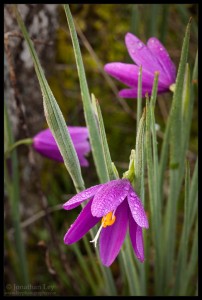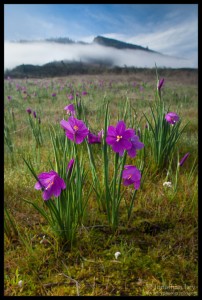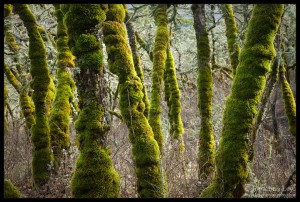I left home around 5am to drive the 1.5 hours out to Rowena Crest to catch the sunrise. It might seem a bit extreme to get moving so early for something that’s supposed to be “fun”, like photography. But, the early morning light has a quality that can’t be duplicated. Getting up early is just one more ingredient to making compelling images.
Grass Widows are the first flower to pop out of the ground in this area. When they’re at peak bloom, they can fill some areas with a wash of magenta. I started at one field I’d visited before, about a mile west of Rowena Crest. The grass widows here were still about a week before peak, but there were a number blooming already. The sun was going to rise soon, so I scoped out a spot with an interesting mix of flowers and rocks, and positioned myself so that the field would be cross-lit, hopefully giving me a good mix of light and shadow to add some more depth to the image. The sun lit up some trees to my side with a deep orange glow, and the shadow line crept toward me. However, it was not to be. Just before the sun arrived at my location, a band of clouds moved in and squashed the moment. Oh well, that’s the nature of nature.

I made the most of it however. The flowers were covered in dew in the early morning, and the air was relatively still. The light was still coming from one direction, filtered through the clouds near the horizon. These are all conditions that only exist in the early morning in a place like this. So, even though I didn’t get the full sunrise experience, conditions were still pretty good – especially for some closeups.
With this shot, I liked how the 3 flowers all showed different sides or stages of the grass widows. I moved my angle to get some separation between the 3 flowers. I had to be very careful not to bump the flowers, as I didn’t want to knock off the dew. One of the hardest things with images like this is picking what to focus on. The two things I wanted most in focus were the dew on the front flower and the stamen of the front flower. Keeping the tip of the front flower in focus was also important. The viewer’s eye expects this to be a sharp edge, so it just wouldn’t look right if that was not in focus. I tried number of minor variations on the focus. I was using a 90mm tilt/shift lens, so that gave me even more options than usual. I was able to tilt the focal plane to more closely align with the main elements of the image. While it’s fine that the flowers in the rear are out of focus, I wanted them to be recognizable as flowers. Since one of the flowers is in focus, the brain can easily imagine what the other flowers look like, and isn’t left guessing.

I then moved up the road a bit to Rowena Crest. The grass widows here were more in full bloom. I wanted to capture a whole field of these flowers, but still get one of the close enough so you could see the detail… and show enough of the environment to give a sense of place. I again used a tilt/shift lens (24mm this time), and moved in very close to this clump of flowers. These were probably only ~6 inches from the front of my lens – right at the minimum focal distance for the lens. I tilted the focal plane to match the ground… this helped, but I still had 2 problems to deal with. The wind had picked up, so I needed a fast shutter speed. I bumped up to ISO1250 (I try not to go much higher than that for these kinds of nature images, as it helps give a more accurate tonal balance). That still wasn’t fast enough, so I had to use a slightly wider aperture than I might have prefered, around f8 I think. This did bring enough focus so that you can see there is a whole field of flowers, and see the mountain in the distance.
Finally, I hiked up that mountain… Tom McCall point. Along the way, I came across these oak trees. The moss was so thick and heavy, it was dripping down the sides of the trunks. I wanted to capture the thickness of this moss.

An added bonus was the soft directional light, which really makes scenes like this glow. The sun was a little higher in the sky now, and being filtered through some high clouds. This softened the light just enough to reduce contrast, but was still directional light – which adds depth. I tried a number of locations before finding one that had a good number of the trees showing. Again, focus is difficult with shots like this. When you have a situation like this, focusing on the subject nearest the lens can work best. These subjects will have the most detail, and let the viewer see that detail, and imagine the same detail in the background. One thing I was surprised and happy with were how the weeds below the trees hid their bases. So, it looks like the green trunks are growing out of a brown fur. This gives a little dreamy quality to the image.
It was a lot of driving on little sleep… but all in all, I was happy with the results!